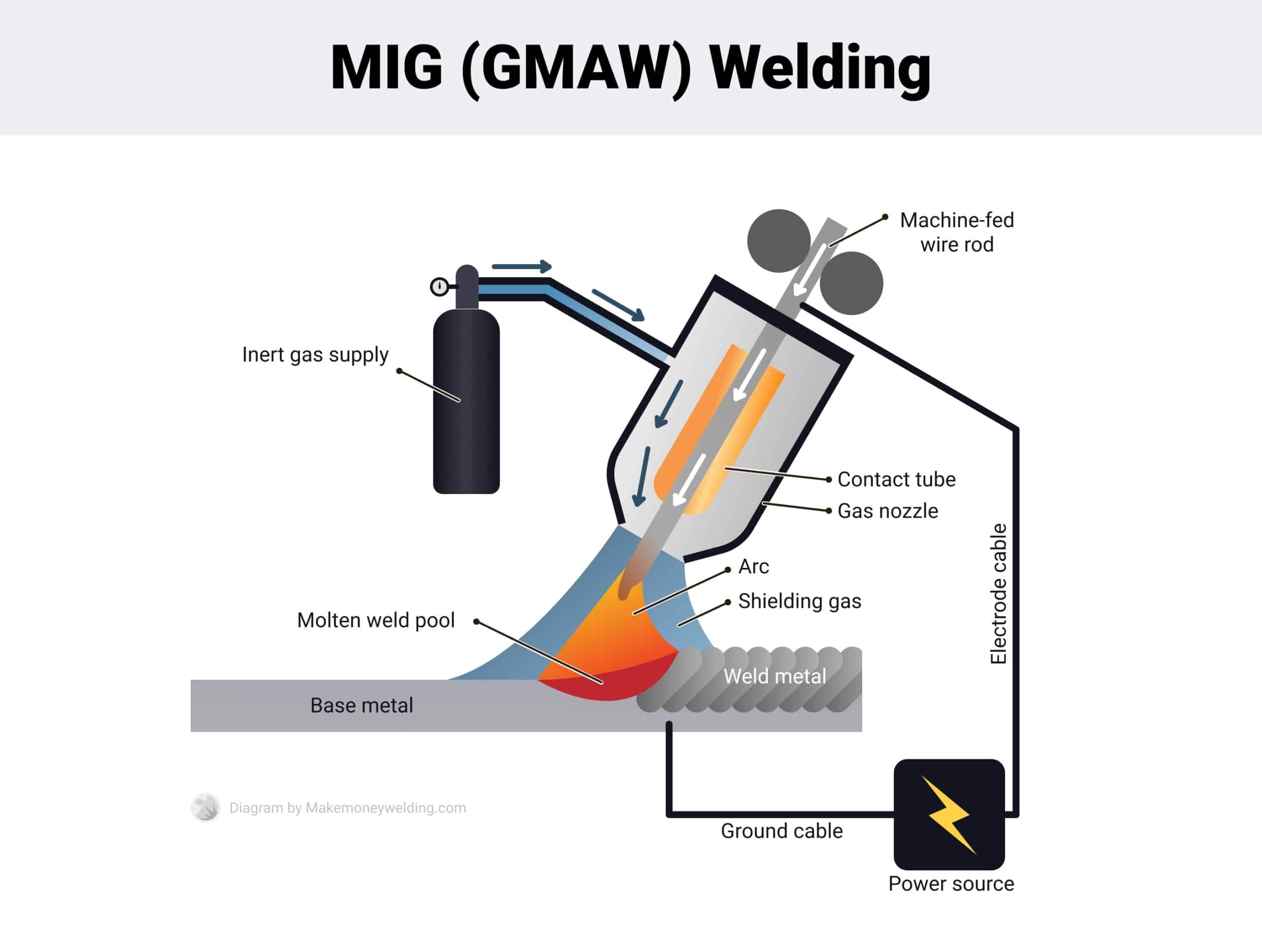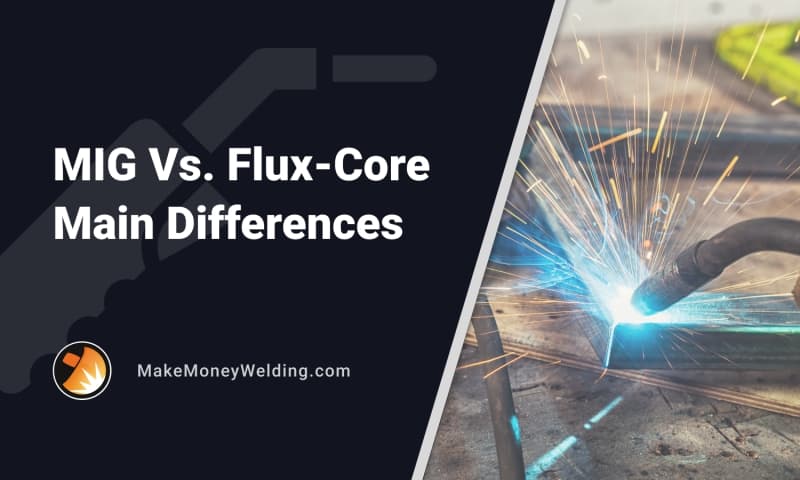Flux-core and MIG welding are among the most popular welding techniques. They have a lot of similarities, as they’re both easy to learn and provide automatic feed to the welding torch.
The main difference between flux-core and MIG welding is that MIG requires a gas tank, while flux-core does not. Because of this, many people call flux-core welding the gasless MIG.
However, these processes have more differences which we’ll unpack throughout the article.
Summary of MIG and Flux-Cored Welding
If you’re short on time, here’s a quick comparison of the flux-core and MIG welding processes:
| Flux-Cored | MIG | |
|---|---|---|
| Learning Curve | Moderate | Moderate |
| Wire Cost | More expensive | Affordable |
| Operating Cost | Moderately priced | Moderately priced |
| Gas Tank Requirement | Not required | Required |
| Surface Prep | Works through dirt, rust and paint | Best for bright white metal |
| Wind | Up to 35 MPH (outdoors) | Less than 5 MPH (indoors) |
| Bead Appearance | Spatter and slag | Little spatter without slag |
| Post Clean Up | Cleaning the slag and spatter | Little need for cleaning |
| Thin Stock | ⅛ or thicker | Down to 24 ga. |
| Thick Stock | Good penetration up to ⅜ inches | Acceptable with enough power |
| Aluminum | Possible although messy | Cleaner than stick welding |
| Cast Iron | Stronger than MIG, with better penetration | Possible, but the weld will be weak |
| Mobility | Easier — no tank | Harder — has a tank |
Flux-Core Vs. MIG Welding – The Similarities
Both techniques are easy to learn and handle as they provide continuous wire feed since both wires act as electrodes.
Also, MIG and flux-core welding provide an automatic feed to the torch. That makes the whole welding process much faster, as it’s continuous and uninterrupted. These welding methods are a much better option for beginners compared to stick welding, where you constantly need to feed the electrodes to the welding machine.
Another similarity between flux-core and MIG is while flux-core uses only flux-cored wires, MIG can use either a solid MIG wire or a flux-cored wire.
When it comes to wires, both are equally good and allow you to weld in multiple positions.
They’re also versatile as they can weld various materials, including:
- Aluminum
- Steel
- Stainless steel
However, there are situations where one will be a better choice than the other!
Below is an illustration showcasing the process of flux-cored arc welding (FCAW).
Below is an illustration showcasing the basic setup for metal inert gas (MIG) welding or gas metal arc welding (GMAW.)

Flux-Core Vs. MIG Welding – The Differences
One of the most important differences is that flux-core welding doesn’t require gas, meaning there’s also no need for a tank. Therefore, flux-cored welding is more portable, provides more mobility, and makes a better choice for outdoor conditions. Read on!
Wire
Both flux-core and MIG welding use a spool of wire which provides the filler metal to the weld. However, these processes use different wires, which sets them apart.
Flux-cored welding uses a tubular wire with flux inside, while MIG welding uses a solid wire.
Wire Construction
The section above shows the main differences between the wires that welders use for MIG and flux-core welding. However, another important detail you should be aware of is the wire construction.
Flux-cored wires function differently than solid wires because of their flux. That said, when using flux-cored wires, you must purchase the right type based on the weld you need and the material you’re working on. Because you need multiple different wires for each welding project, flux-core welding can become overwhelming.
Also, in some cases, your flux-cored wires will require specialized storage conditions. Otherwise, they would go bad. That also makes these wires harder to store compared to solid wires.
Shielding Gas
As we mentioned earlier, the most significant difference between flux-cored and MIG welding is that MIG welding requires a shielding gas, whereas flux-cored welding doesn’t.
The gas tank is essential for performing a proper MIG weld, as its primary purpose is to shield and protect the weld from the air. Otherwise, there would be defects, and your weld wouldn’t be as strong as supposed to be.
Flux-cored welding does experience the same problem but has a different resolution. Instead of needing a gas tank, flux-cored welding relies on the flux inside the wire to protect the weld.
Because of this feature, people often refer to flux-cored welding as gasless MIG welding.
While that makes flux-cored welding more convenient, it also increases the work after welding. The flux-cored wire also produces slag, which requires more cleanup afterward.
You should also remember that there are two types of flux-cored wires based on the kind of shield they provide. They can be:
- Self-shielded: The most common type of flux-cored wires.
- Dual-shielded: These flux-cored wires have protection from their flux but also need additional shielding from gas tanks.
Polarity
Flux-cored and MIG welding have different polarities on their torch, which also sets them apart.
MIG welding requires you to set the wire to the positive terminal, following the direct current electrode positive (DCEP) settings.
On the other hand, for flux-core welding, you need to follow the direct current electrode negative (DCEN) settings and connect the wire to a negative terminal.
However, some flux-cored wires require a positive electrode arrangement, which is something to remember when setting your polarity during flux-core welding.
Also, if a MIG welder uses a flux-cored wire, it can switch between the terminals.
Filler Material
MIG wires are solid, making them suitable for most passes as they contain purer filler materials than flux-cored wires. Also, their alloy is commonly the same as the material you’re welding.
Flux-cored wires contain additives along with their flux, making them significantly different from solid MIG wires.
The term flux-cored wire is quite broad as flux-cored wires are designed to work with a particular metal, which will affect the flux and alloy mixture inside the wire. That requires you to check whether the flux-cored wire makes the weld suitable for multiple passes.
It’s best to verify the rate of your flux-cored wire to ensure it will function for your needs.
Strength
The strength differences between flux-cored and MIG welding are insignificant and almost unnoticeable. Both welds will be good as long as you do them right. If you’re using the proper wires, settings, and welding technique, there won’t be distinctions between the welds.
However, there is a slight difference when welding cast iron, which you can also see in the chart at the beginning of our article.
Flux-cored welding is a better option for welding cast iron as it provides better penetration and stronger welds. It’s not impossible to use MIG welding to weld cast iron, but the weld would be weak.
Penetration
Both types of wires (flux-cored and solid MIG) penetrate well. However, there are differences in the way they penetrate.
The flux-core electrode provides heat with more focus, differentiating flux-core arc welding from gas metal arc welding. Therefore, flux-cored welding makes a better choice for thick materials.
Which Is Better?
There’s no right or wrong answer to which welding technique is better, as both flux-core and MIG welding are excellent options.
However, in some cases, one is preferable to the other.
Surface Preparation
When it comes to surface preparation, flux-cored welding is much easier than MIG welding because it can handle dirt, rust, and paint. It can cut through contaminated material areas, removing all the dirt and metal oxides.
On the contrary, MIG welding is unsuitable unless the surface is bright white metal and doesn’t handle dirt, paint, or rust. Because of that, flux-cored welding is a more suitable choice when the metal you’re working on is not pristine white.
Appearance
The final product and the appearance of the weld are much sleeker when using the MIG welding process. MIG welding produces almost no spatter, while flux-cored produces slag, spatter, and spitting.
That makes MIG a better choice when you want a cleaner weld and less need for cleaning after you finish welding.
Outdoor Work
Flux-cored welding is a much better option when welding outdoors, which you can also see in the chart at the start of our article. As flux-cored wires get protection from the flux inside the wire, their welds can withstand winds up to 35 MPH.
MIG welding gets protection from the gas tank, which would get blown away if the wind reaches 5 MPH.
Thin Stock
The MIG process becomes a better option when welding thin stock than flux-cored welding. Because it has a penetration down to 24 ga, MIG welding typically won’t burn through the material.
Also, it’s not uncommon for thin stock to need painting after the welding is finished, which will be much easier with cleaner MIG welds.
Costs
The cost comparison between these two welding processes can be somewhat complicated as people have clashing opinions. Most people consider MIG welding more affordable because solid MIG wires cost less than flux-cored wires.
However, MIG welding requires higher upfront costs as you also need a gas tank and additional components like a flow meter and a regulator.
Cast Iron
As we already discussed, flux-cored welding is a much better option when welding cast iron. It provides better penetration and welds than MIG, which can weld cast iron, but the welds would be weak.
Aluminum
MIG is the clear winner when welding aluminum, but you’ll probably need a spool gun. It provides clean welds, which work great for aluminum considering most parts remain exposed.
Galvanized Steel
Flux-cored welding is more suitable when welding galvanized steel as it can penetrate through the galvanization and form a decent weld.
On the contrary, if you wanted to use MIG welding for galvanized steel, you would need to grind off the galvanization, which requires more time and complicates the process.
Related: How To MIG Weld Stainless Steel
Pros vs. Cons Summarized
Flux-Cored Wire
Pros
- Easy to learn and set up
- Excellent choice for outdoor conditions
- Affordable to operate
- No gas tank
- Portable
- Tolerates dirt, rust, and paint
- Great for welding steel and cast iron
- Better penetration that works great for thick stock
Cons
- Expensive wires
- Produces spatter and slag
- Requires more cleaning
- Not suitable for aluminum welds
- Not good for thin stock as it would blow through
- High level of fumes
Solid MIG Wire
Pros
- Simple to learn
- Cleaner and neater welding process compared to flux-cored
- Affordable wires
- Great choice for thin stock
- Works well with aluminum
Cons
- Not suitable for outdoors
- Harder to set up for a new weld
- Starting expenses are higher as you need gas
- Not a good option for cast iron
- Needs bright white metal
- Not suitable for cast iron welds
- Requires a tank
FAQs
Is MIG or Flux-cored Stronger?
Overall, both MIG and flux-cored welding are strong. However, in certain situations, one will be stronger than the other and, therefore, a better choice for that task.
– MIG welding is stronger when welding thin stock
– Flux-core welding is stronger when welding thick stock
– MIG welding is stronger for aluminum work
– Flux-core welding is stronger for cast iron and galvanized steel
– Flux-core welding is stronger when working on a surface with rust, dirt, and paint.
– Flux-cored welding is stronger for outdoor conditions
How Do I Know If My MIG Welder Can Run Flux-cored Wire?
While some MIG welders can run flux-cored, others can’t. To verify this, all you need to do is check if your MIG welder has the option to change its polarity or not.
MIG welding requires the polarity to be set to a positive terminal. Contrary, flux-core welding requires the polarity to be set to the negative terminal.
If your MIG welder can change polarities — It can run flux-cored wires. If there’s no option to change the polarity, you’ll need to invest in a new MIG unit with this feature.
Is A Gasless Welder A Contradiction Of Terms?
Technically speaking, yes. A MIG welder is designed for welding with an external shielding gas, which is contradictory as it can not be gasless.
However, the term has become common to describe the process “flux-core welding” which is very similar to MIG welding but does not require an external shielding gas.
Is MIG or Flux-cored Welding Easy To Learn?
MIG and flux-core are semi-automatic welding processes, making them both easy to learn, especially compared to other welding processes. This is why many newbie welders first learn these techniques.
Wrapping It Up
There’s no need to say that both flux-core and MIG welding are excellent welding techniques with their benefits and disadvantages.
However, as a beginner welder, it’s helpful to learn more about each welding process and determine when one makes a better choice than the other.
Once you learn how to use each technique to achieve a good weld properly, you’ll become a better welder and enhance your welding skills.



Great info Garrett! I did a little welding when I was young but found it easier to pay good welders for my small projects later. Now at 76 I moved 17 miles from a small Idaho town and 140 miles from the nearest Walmart or fast food store and I have 4 or 5 small welding projects that are difficult to get done here. So I’m going to buy an inexpensive welder (flux-core after reading your very well done comparison) for my projects and projects I know will come up in the future. I have collected scrap pieces to practice on and can’t wait to start welding! Thanks, Hugh J